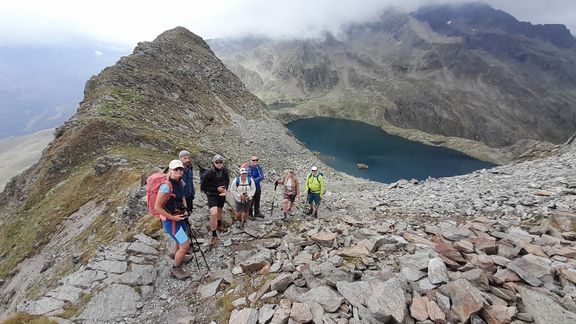Focus on the Schobergruppe
The Schobergruppe, the oldest part of the Hohe Tauern National Park, is known for its spectacular landscape and the diverse opportunities for mountaineers and nature lovers. At the same time, the rugged and high alpine terrain, often referred to as the ‘Karakorum of the Alps’, places high demands on the conservation of natural resources and the development of a sustainable tourism infrastructure. Despite the comparatively low level of alpine tourism, there are urgent questions regarding the preservation of alpine huts and trails, future trends in mountain sports and their impact on the protected area. The participant and mountain guide of expedition.nationalpark, Ernst Rieger, impressively describes ‘that the meeting of the diverse expertise from the expedition group with the local dialogue partners opens up new perspectives on this topic, which show visions for the future’.
The six-member expedition group, consisting of local experts from Alpine associations and scientists from Carinthia University of Applied Sciences and Alpen-Adria University of Klagenfurt, will explore the current situation in dialogue with local stakeholders. The event took place along the famous hiking trail Wiener Höhenweg, with a first overnight stay at the Alpine hut Winklerner Hütte. The hike to the Wangenitzseehütte, with an overnight stay and the descent through the Wangenitz valley, concluded the tour. Along the way, the group was able to discuss current issues, perspectives and potential conflicts with seven dialogue partners from the region in order to create ideas for a shared vision of the future. A variety of trends emerged, including social discourse on new mountain sports, the advantages and disadvantages of digitalisation in tour planning, as well as changing social values, the generational shift and its impact on the national park, and the preservation of Alpine infrastructure.
Challenges in extreme situations
The findings of the three-day visit will be analysed in collaboration with Carinthia University of Applied Sciences and further processed in two subsequent workshops with local stakeholders. Barbara Pucker, Director of the the Carinthian portion of Hohe Tauern National Park, expressed her satisfaction with the experiences of the expedition: ‘The insights we gained during these days are not only of great importance for the future development of the Schobergruppe, but can also be transferred to other mountain ranges in protected areas. Alpine infrastructure offers protected areas a tool for connecting people, nature and culture’.
The experiences and observations from the first two expeditions have resulted in a book that can be read in digital form on the national park's data platform (www.parcs.at). The results of expedition.nationalpark.2024 are also being prepared in the form of a book and will be available both for the further development of the national park and to inform the interested public.
The project was supported by funding from the Province of Carinthia and the European Union.

